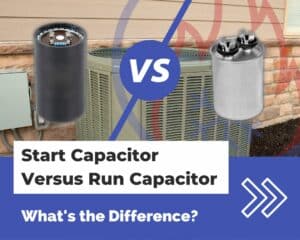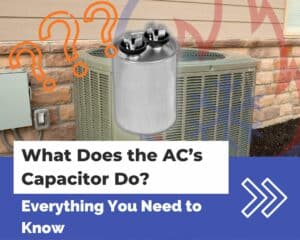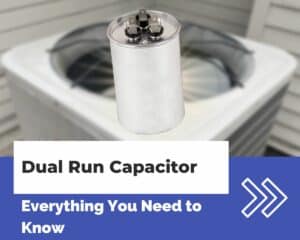Every time your AC unit starts up, it consumes a ton of energy—way more than it does to stay running. This increased energy usage turns into heat that will wear out your compressor’s internal components—one startup at a time.
So how do you ensure that your compressor doesn’t wear itself out as it starts up thousands of times over the summer? You’ll need to minimize the startup period and ensure that your AC’s compressor starts up in the shortest amount of time possible.
This is where the AC hard start kit comes in.
In this article, I’ll explain how AC hard start kits work, and the benefits of using an AC hard start kit. I’ll also go over how to tell if your AC needs a hard start kit and how to choose the correct hard start kit for your AC unit.
How does an AC hard start kit work?
An AC hard start kit works by using a start capacitor to give the AC’s compressor an extra jolt of energy to start up. After the compressor starts up, a relay removes the start capacitor from the circuit to prevent the capacitor and compressor motor from burning out.
The hard start kit wires into the compressor’s start winding. When the compressor starts up, the capacitor creates a phase shift in the motor’s start winding, providing extra starting torque to get the motor going.
Start capacitors aren’t designed to be used continuously. While they provide a huge boost of energy, they will overheat and fail if kept in the compressor motor’s circuit for too long. That’s where the relay comes into play.
Once the compressor approaches full speed, the relay opens up and removes the start capacitor from the circuit. This prevents the capacitor and compressor from overheating and burning out.
Next, I’ll go over the different types of hard start kits.
Types of AC hard start kits
There are two main types of hard start kits:
Of these two types of hard start kits, the potential relay is generally preferred, especially for ACs with thermostatic expansion valves (TXVs).
However, a PTC hard start kit will usually work fine for ACs with capillary tubes or fixed orifice restrictors.
Potential relay hard start kits
The potential relay hard start kit uses a relay device to switch the start capacitor out of the compressor motor’s circuit.
When the compressor motor starts running, it generates a back electromotive force (EMF) that manifests as a voltage.
This voltage triggers the relay to remove the start capacitor from the compressor motor’s circuit when the compressor reaches approximately 80% speed.
Potential relay hard start kits are advantageous because they are designed to remove the start capacitor from the circuit when the compressor approaches full speed.
Another advantage of a potential relay hard start is that it can accommodate repeated start/stop cycles of an AC compressor since it doesn’t need to cool down between cycles.
PTC relay hard start kits
The positive temperature coefficient (PTC) relay hard start kit uses a temperature-controlled relay to remove the start capacitor from the compressor motor’s circuit.
When the compressor motor starts running, the PTC relay heats up. Once the PTC relay reaches a certain temperature, the relay opens up and removes the start capacitor from the compressor motor’s circuit.
PTC relay hard start kits are advantageous because they are low-cost and somewhat universal—the same PTC hard start kit can be used in a variety of AC units.
However, a PTC hard start kit can sometimes cause increased wear on your compressor since it doesn’t rely on feedback from your compressor. This means that a PTC relay will sometimes stay in the circuit for too little or too much time, depending on the run conditions.
What are the benefits of using an AC hard start kit?
AC compressors use a lot of energy to start up. And during the startup period, an AC compressor will experience some wear and tear from the increased load on its windings.
Why does that even matter? Doesn’t a compressor only take a split second to start up?
Even though a compressor’s startup period is nearly instantaneous, over time all of those compressor startups will slowly wear it down. Especially when most ACs start and stop thousands of times each year.
Eventually, the compressor will slowly wear itself out if it’s having trouble starting up.
Here are some benefits of using an AC hard start kit:
- Helps the AC’s compressor start quickly
- Reduces the energy that the compressor uses to start
- Reduces heat in the compressor’s windings when starting, causing less wear
- Increases the lifespan of the compressor
So how does a hard start kit help your AC’s compressor start up, anyway?
A hard start kit helps your AC’s compressor start by providing an extra jolt of energy to get it running.
The AC’s compressor draws around seven times the amount of amps when starting up compared to running.
By providing extra energy, the hard start kit helps the compressor startup in less time—reducing heat gain and wear and tear in the compressor’s windings.
But don’t be mistaken—a hard start kit doesn’t help the AC’s compressor consume less amps when starting.
The hard start kit shortens the time that your AC’s compressor draws startup amps.
The net effect is that your AC’s compressor is in its start-up period for a shorter period of time.
How to tell if your AC needs a hard start kit
While most AC compressors will benefit from the use of a hard start kit, there are a few situations where installing a hard start kit will be highly beneficial:
- You have an older AC unit that’s having trouble starting
- Your AC unit has a long line set
- Your AC unit is located in an area with low ambient temperatures
- Your home’s lights are dimming when your AC unit starts up
Additionally, adding a hard start kit to your AC may help extend the life of an older compressor—keeping it going for the rest of the season until you’re able to get a new unit installed.
But don’t be mistaken—only certain types of AC compressors can use a hard start kit.
Here are the types of AC compressors than can use a hard start kit:
- Single-stage PSC rotary compressors
- Single-stage PSC scroll compressors
- Single-stage PSC reciprocating compressors
So how can you tell if your AC doesn’t need a hard start kit?
If your AC has one of the following, then it can not use a hard start kit:
- Inverter compressor
- Variable speed compressor
- Two-stage compressor
How to choose the right hard start kit for your AC unit
The best hard start kit to use for your AC unit is the one that the manufacturer specifies.
This means that you should take a look at the installation manual for your AC unit to see if it calls out which hard start kit should be used in your unit.
If the installation manual doesn’t denote which hard start kit should be used, then you should contact the local dealer for the brand of AC that you have. They should be able to get you a factory hard start kit for your AC unit, direct from the manufacturer.
If the manufacturer-specified hard start kit is not available for your AC unit, then an aftermarket hard start kit usually works fine. However, you need to ensure that you pick the correct one.
- If your start capacitor doesn’t have enough capacitance, then your run winding may overheat and get damaged.
- If your start capacitor has too much capacitance, then your start winding may overheat and get damaged.
For these reasons, you’ll want to ensure that your start capacitor has the correct farad rating.
Most aftermarket hard start kits have a horsepower (HP) rating that loosely translates to the farad rating of their capacitor.
You’ll need to figure out the horsepower rating of your AC’s compressor, then choose a hard start kit that matches the rating of your compressor.
Furthermore, you also need to ensure that the type of relay in your hard start kit is compatible with your AC unit:
- If your AC unit has a thermostatic expansion valve (TXV), then you need to use a hard start kit with a potential relay.
- If your AC unit has capillary tubes or a fixed orifice restrictor, then a hard start kit with a positive temperature coefficient (PTC) relay will work fine.
After you choose the right hard start kit for your unit, follow the instructions that come with the kit to install it in your AC unit.
This video from Jay at Word of Advice TV shows you how to install a hard start kit in your AC. Jay also provides some helpful tips and tricks that you can use when installing your hard start kit.




thanks, had a airconditioner “Haier”do an AC power outage on/off while calling for the compressor.
so now when there’s call for cold something is tripping it off like an overload.
could this be the compressor i changed the capacitor with the same results
the article was very educational. thanks for the help
Hi Emily,
It definitely sounds like some sort of compressor or capacitor issue. I recommend getting an HVAC professional to diagnose your system further.
-Trey